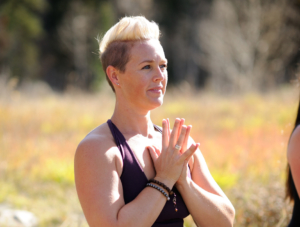 Happy Earth Day! This Friday, April 22nd, we’ll celebrate the spectacular planet we live on and recommit to living in a way that allows it to flourish.
Happy Earth Day! This Friday, April 22nd, we’ll celebrate the spectacular planet we live on and recommit to living in a way that allows it to flourish.
Earth Week is a great time to reassess our energy consumption and decide where we can refine or let go of patterns of overconsumption. This includes all areas of our lives—how we eat, how we travel, how we work and how we play. It also includes how we practice yoga.
One way to “green” our yoga practice is to use mats, blocks, straps, etc., that are made from sustainable materials—rubber, TPE and PER yoga mats, bamboo and cork blocks and cotton and hemp straps.
But how sustainable is your actual yoga practice? Asana practice has the unique ability, among physical activities, of helping us replenish the prana (life energy) we spend during our daily activities. We spend prana when we talk, move about, and use our brains to think and/or solve problems as we move through our day. We take in prana through food, water, breath and what we “feed” our minds. Asana practice, with its unique marriage of breath and movement, can help us restore our energy reserves.
Turn Off the Lights!
In every asana there are parts of the body that need to engage more fully and parts that can soften. When we tense or harden parts of the body that aren’t directly involved in the foundation of our pose, we are using energy where it isn’t needed, kind of like leaving the lights on in a room you’re not occupying.
Creating a Sustainable Yoga Practice
Creating a sustainable yoga practice requires intention. Here are some ideas that might help:
- Set a strong, rooted foundation. Whatever is on the ground in your practice is your foundation. In order for your practice to be sustainable, your foundation must be strong and grounded. This allows the areas above the ground to work less. For example, in standing poses, the legs are active and the upper body can soften and open.
- Let go of effort in what’s above your foundation. Our shoulders, neck, throat, jaw and eyes are common areas where we express tension and stress. Check these areas and let go of unnecessary effort.
- Check your breath. This is the most important cue for making your practice energy-producing rather than energy-depleting. In every pose, check your breathing. Is it deep and full; does your belly expand and contract as you inhale and exhale? Is it fast, shallow, labored or based in the chest? If you find your breath labored or restricted, do less. Doing the “full” expression of a pose is not nearly as important as maintaining your ability to breathe deeply. As my teacher, Donna Farhi, says, “Give your breath primacy.”
- What are the aftereffects of your practice? If you feel tired or agitated after your asana practice, you might want to re-examine how you’re practicing. Asana practice is supposed to replenish us, not fatigue us.
- Slow down. Not only does a slower practice tend to build rather than deplete energy, but it gives you a chance to investigate how you’re practicing—whether you’re spending energy in parts of your body that don’t need to be working so hard.
- Cultivate contentment. Santosha, the cultivation of contentment, is one of the niyamas on the Eight Limbs of Yoga. When we are content with our lives in this moment, we don’t need to go outside ourselves to find happiness. We can practice santosha on the mat too. Appreciate the pose you’re in at this moment. Appreciate this breath. There’s no pose out there somewhere in the future—or somewhere in the past—that’s better than the one you’re in now. Be fully aware and alive in this pose, right now.
- Give yourself a generous Savasana. Judith Hanson Lasater recommends at least 15 minutes for Savasana if you want to relax your body completely and allow your mind to settle.
The Power of Choice
I like to think of my yoga and meditation practices as the time when I get to observe my habits of body and mind. This is where the true power of practice lies. When we see clearly that we are practicing a habit that may be causing difficulty somewhere else in our lives—e.g. tensing our shoulders or jaw in asana practice and then complaining of neck and shoulder tension—we have a chance to make a different choice.
When I become aware that something I’m doing in my yoga practice is draining my energy, I can start to dismantle my old habit and cultivate a newer, healthier one. Over time, that new habit integrates into my daily life. When my mind and body are sustained, I feel more self-contained and less likely to go outside myself to have my needs met, which brings us back to sustaining our beautiful planet.
